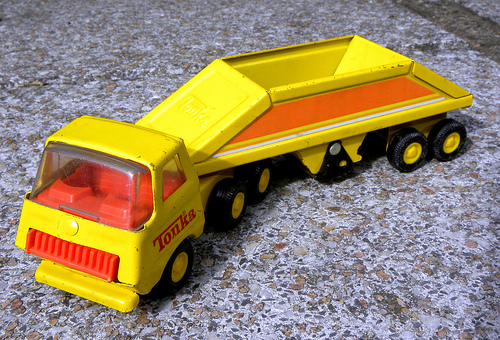Here’s an interesting study (not free, unfortunately) by UW engineering prof Stephen Muench, reviewing the literature on the energy and CO2 impacts of road construction. His study looks mostly at the construction phase itself, rather than the use of the road. In a nutshell: manufacturing roadway materials generates somewhere between 60 and 90 percent of the CO2 emissions associated with road building. Transportation of equipment and materials to the job site accounts for 10 to 30 percent, and construction activities at the job site itself account for less than 5 percent of CO2 and energy use.
What I think is so interesting here is that the things that you don’t see matter much more than the things that you do. When I think about road construction, I imagine a bunch of construction equipment: graders, steam rollers, bulldozers, and all the other big energy-hungry machines that fascinated me when I was about 3 years old. But for greenhouse gas emissions, construction equipment is just the tip of the iceberg. The most significant energy and CO2 impacts happen elsewhere, in the places where 3 year-olds aren’t allowed to visit: in the factories that make cement and rebar, the mines where we get the raw materials, and the roads and railroad tracks they’re shipped on.
But even if you widen your horizon beyond the job site to the comprehensive impacts of road construction, you’re still just looking at the tip of the iceberg. According to Muench’s review:
Ultimately, roadway construction’s contribution to energy use and emissions associated with transportation is small, by some estimates…in the range of 1/18 to 1/20 that of roadway traffic use. [Emphasis added.]
In short, the impacts of the entire road construction phase are typically little more than a rounding error, compared to the fuel consumed by the cars that drive on the new roads.
A few years back, we took a similar look at the effect of road widening on greenhouse gas emissions, based on some of the very same studies that Muench uses. And we our study had very similar results: in a crowded urban area, the GHGs from materials and construction are dwarfed by the fuel generated by increased traffic from widened highways.
Still, I often hear discussions of the “construction impacts” of road projects focusing on the construction equipment itself. But those discussions are looking at just the tip of the tip of the iceberg. If you’re really worried about the impacts of new road projects, the smart thing is to focus on where the impacts are biggest: on the cars and trucks that will ultimately fill the roads we build.










Bentler
I think 5% of transportation GHG & energy flow is enormous when we know we have to eliminate carbon pollution. https://flowcharts.llnl.gov/ (energy flow graphs)
People love the freedom of cars yet sit in traffic jams every day and will do the same in electric cars. Our transportation system is obsolete and wasteful, designed long before computers and networks existed. Let’s do better, design for zero carbon, target scalable mobility with a lightweight, wired and networked system and eliminates the weight and the waste. I hope Bill Ford gets it based on his recent TED speech – http://tinyurl.com/5uf4grw
Andrew
I’m not sure Bill Ford gets it. Mobility should not be celebrated by the trips one takes to work and back every day. By eliminating the mundane trips, ones which by no means represent freedom or the pleasure of moving around, we eliminate the vast majority of miles traveled on the roads.
The 2050 goal should be to reduce the number of vehicles on the road, even if they are electric, not quadruple the number. We don’t need special technology to do this, only better community designs and transportation choices based on existing technologies. Technology will play a role to improve things, but it won’t solve the problem of 4 billion vehicles on the road… so lets not go there.
One can always rent a car (a new one) on the weekends to do those “freedom” trips, if that’s one’s desire.